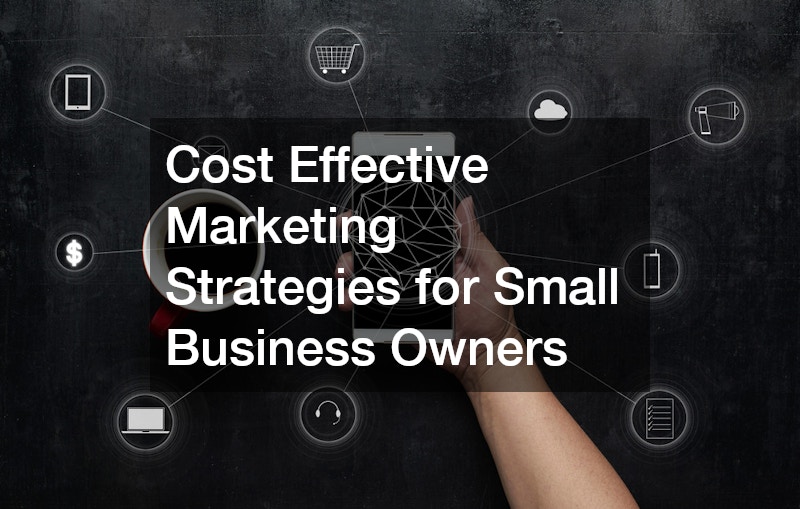Marketing is one of the most powerful tools a small business owner can use to build awareness, attract customers, and drive long-term success. However, many small businesses struggle with limited budgets, making it essential to find ways to reach potential customers without overspending. The key lies in adopting cost effective marketing strategies that maximize results while minimizing expenses. By focusing on creative outreach, digital channels, and strong community relationships, small businesses can build a loyal customer base and compete with larger companies. These strategies not only save money but also establish credibility and trust, helping small business owners thrive in competitive markets.
Building a Strong Local Presence Through Community Engagement
For small business owners, one of the most powerful and affordable marketing tools is community engagement. Participating in local events, sponsoring community activities, and supporting neighborhood initiatives help increase visibility while showing customers that your business cares about the community it serves. These personal connections create a sense of loyalty that advertising alone cannot achieve. Community involvement also fosters valuable word-of-mouth referrals, a key driver of growth for many small businesses looking to stretch their marketing budgets effectively.
A great example of this principle can be seen in how an electrical contractor might build brand recognition. By volunteering services for local charity projects or sponsoring school events, the business not only provides a valuable service but also reinforces its reputation as a trusted local provider. These efforts highlight the power of relationships over expensive ad campaigns. When combined with effective marketing strategies such as local SEO and referral incentives, community engagement can deliver long-term results while keeping spending low.
Leveraging Social Media Platforms for Affordable Brand Growth
In today’s digital age, social media has become one of the most accessible and cost effective marketing tools available to small business owners. Platforms like Facebook, Instagram, and TikTok allow companies to connect directly with their audience, promote new products or services, and build brand awareness in real time. By creating engaging content and responding to followers, businesses can form authentic relationships that drive both sales and loyalty. Unlike traditional advertising, social media provides measurable results, helping owners refine their strategies to focus on what truly resonates with their target audience.
Social media advertising offers a flexible, budget-friendly way to compete with larger brands. For instance, a small bakery, boutique, or repair shop can run affordable, location-based ad campaigns to attract customers within a specific radius. With features that allow daily spending limits and precise audience targeting, businesses can maintain control over their costs while reaching the people most likely to convert. For entrepreneurs focused on growth, social media advertising stands out as one of the most practical tools for achieving visibility, engagement, and steady customer expansion without breaking the bank.
Using Niche Marketing to Reach Targeted Audiences
One of the smartest approaches for small business owners is to focus on niche marketing. Instead of trying to appeal to a broad audience, niche marketing zeroes in on a specific group of customers who are most likely to benefit from your product or service. This allows businesses to craft more precise messages, develop deeper customer relationships, and reduce wasted spending on ineffective outreach. The power of niche marketing lies in its efficiency—it ensures that every marketing dollar works toward reaching the right people, which is the foundation of cost effective marketing.
For example, physical therapy marketing often targets clients recovering from injury, surgery, or chronic pain. By creating tailored content such as recovery guides, testimonials, and educational videos, a physical therapy clinic can build authority within that specific audience. Instead of spending heavily on general ads, the clinic can focus on keyword-based digital campaigns or referral partnerships with local gyms and physicians. These efforts demonstrate how niche marketing not only saves money but also generates stronger, more loyal customer connections through strategic focus and personalized outreach.
Creating Strategic Partnerships to Expand Brand Visibility
Forming strategic partnerships is another excellent way for small businesses to expand their audience without dramatically increasing costs. Collaborations allow companies to share resources, audiences, and marketing platforms for mutual benefit. Whether through cross-promotions, bundled offers, or co-hosted events, partnerships provide an opportunity to reach new customers while reinforcing trust through association with other reputable businesses. This collaborative model aligns perfectly with the principles of cost effective marketing by reducing expenses while amplifying results.
A clear example can be seen in how limousine companies might partner with wedding planners, event venues, or local florists. By cross-promoting one another’s services, each business gains access to a broader audience without additional advertising costs. These partnerships not only increase visibility but also build credibility since customers perceive such collaborations as convenient, trustworthy, and professionally aligned. For small business owners, this strategy highlights how teamwork and shared marketing efforts can generate big returns without the burden of high spending.
Hosting Memorable Events to Increase Customer Interaction
Hosting events—whether in-person or virtual—is one of the most effective ways for small businesses to connect directly with their target audience. Events provide opportunities to showcase products, build relationships, and create memorable experiences that lead to long-term loyalty. They also give small business owners valuable feedback and insights into customer preferences. Because events can be tailored to different budgets, they are a practical component of cost effective marketing, offering high engagement at a fraction of the price of traditional campaigns.
A creative example is how businesses can host themed gatherings similar to casino parties to attract and entertain clients. Whether it’s a customer appreciation night, charity fundraiser, or product launch with fun incentives, these events foster excitement while building brand awareness. They also generate shareable moments for social media, extending reach beyond the attendees. By combining entertainment with marketing, businesses can create experiences that strengthen customer relationships and encourage repeat business—proving that marketing doesn’t always have to rely on big budgets to make a big impact.
Showcasing Products With Creative and Personalized Promotions
Creativity often makes the difference between being noticed and being overlooked. For small business owners working with limited budgets, personalized promotions can have a major impact without requiring large-scale ad campaigns. Creative promotions—like limited-time offers, loyalty rewards, or personalized product packaging—capture attention and make customers feel valued. By tailoring marketing messages to customer interests and purchasing habits, businesses can inspire repeat sales and generate organic referrals. This approach embodies cost effective marketing because it prioritizes connection and creativity over expensive advertising.
For instance, a cookies shop could introduce custom gift boxes, local holiday bundles, or social media contests that encourage customers to share their experiences online. These small, thoughtful gestures attract attention while building a sense of community around the brand. The shop could also offer discounts for bulk orders or collaborate with nearby coffee shops to cross-promote products. Each strategy strengthens customer engagement while maintaining affordability. Through creative and personalized promotions, small businesses can expand visibility, boost loyalty, and stand out in their local markets.
Highlighting Sustainability to Appeal to Eco-Conscious Customers
Today’s consumers increasingly value sustainability, and aligning your business with those values can help attract a loyal and environmentally aware customer base. Highlighting your commitment to eco-friendly practices not only enhances your brand image but also opens the door to a growing market segment. Many sustainable initiatives—like reducing waste, sourcing local materials, or using renewable energy—also reduce operational costs, making them a win-win for business owners. Incorporating these efforts into your messaging reflects modern values while supporting cost effective marketing.
For example, companies that install residential solar panels can promote both their service and their mission to support a greener planet. By showcasing environmental benefits alongside potential energy savings, they appeal to customers who want to make responsible investments. Educational blog posts, community workshops, and customer testimonials can further strengthen trust and visibility. This strategy shows that sustainability and affordability can go hand in hand, helping small businesses make a meaningful impact while staying financially efficient.
Improving Customer Service as a Form of Organic Marketing
Exceptional customer service is one of the most powerful and inexpensive ways to market your business. When customers feel valued, they naturally share their positive experiences, generating word-of-mouth referrals that no paid campaign can match. By focusing on responsiveness, professionalism, and genuine care, small businesses can turn everyday interactions into lasting impressions. This form of organic outreach reinforces trust and loyalty, making it a cornerstone of cost effective marketing for business owners who prioritize relationships over ad budgets.
Consider how towing services, for example, can use customer service to build strong reputations. Prompt response times, clear communication, and compassionate support during stressful situations create positive experiences that customers remember. Those satisfied clients often recommend the business to others or leave positive reviews online, amplifying its reach without added expense. This approach demonstrates that excellent service is not just good ethics—it’s a sustainable, low-cost marketing strategy that continues to generate results long after the initial interaction.
Optimizing Online Visibility With Search Engine Strategies
In today’s digital-first economy, being visible online is essential for any small business looking to attract new customers. Search engine optimization (SEO) remains one of the most powerful and cost effective marketing techniques because it focuses on long-term visibility rather than short-lived campaigns. By optimizing your website content, improving site speed, and using relevant keywords, your business can climb search rankings and consistently attract new visitors without relying on expensive ads. SEO also builds credibility—customers naturally trust businesses that appear near the top of search results.
For example, a window company can benefit tremendously from a well-executed SEO strategy. By publishing blogs about window maintenance, energy efficiency, or seasonal upgrades, they can attract homeowners searching for reliable information. Incorporating local keywords ensures that their business appears when nearby customers are looking for related services. Over time, this steady flow of organic traffic creates a sustainable customer pipeline without recurring ad costs. Combining strong SEO with a clear call-to-action turns online visitors into loyal clients, demonstrating how digital visibility strengthens business growth and supports long-term affordability.
Adapting Proven Industry Models for Maximum Return
Many small business owners make the mistake of thinking innovation always means starting from scratch. In reality, adapting proven industry models can be one of the most efficient ways to achieve results with minimal risk. Observing what works in similar markets or industries helps entrepreneurs refine strategies and apply them in creative ways. This approach eliminates trial and error, reduces wasted effort, and allows business owners to learn from established successes. Emulating effective models while adding a unique touch is a form of cost effective marketing that blends creativity with practicality.
Take grain marketing as an example—an industry where success relies on understanding market trends, timing, and buyer behavior. Small businesses in any field can apply similar principles by monitoring competitors, identifying seasonal opportunities, and adjusting pricing or promotions based on consumer demand. Learning from tried-and-true systems ensures that your marketing investments produce consistent, measurable results. By adapting proven strategies to fit your unique brand identity, you can minimize costs, maximize return, and maintain flexibility in a changing market.
Small business owners often face the challenge of doing more with less—but effective marketing doesn’t have to break the bank. By combining creativity, consistency, and strategy, any business can expand its reach and strengthen its brand without overspending. The most successful cost effective marketing methods are those rooted in authenticity—connecting with customers through community engagement, excellent service, and meaningful storytelling. Digital tools like SEO, social media, and data tracking give small businesses the power to compete with larger companies on a more level playing field. When these are paired with traditional outreach like events, partnerships, and referrals, the results can be transformative.
However, cost effective marketing is not just about saving money—it’s about investing resources wisely. Each of the strategies outlined, from niche marketing to sustainability efforts, demonstrates how thoughtful planning can lead to measurable growth. Businesses that prioritize customer relationships, clear messaging, and local visibility tend to see stronger loyalty and more consistent sales. Over time, these efforts build a resilient brand that thrives through both economic challenges and opportunities.
Ultimately, the key to sustainable success lies in balance: blending creativity with data, innovation with proven tactics, and affordability with value. Small business owners who embrace this approach can continue to grow their presence, maintain loyal customers, and reach new audiences—all without stretching their budgets thin. By understanding and applying these principles, any entrepreneur can transform limited resources into lasting results, proving that effective marketing is about strategy, not just spending power.




